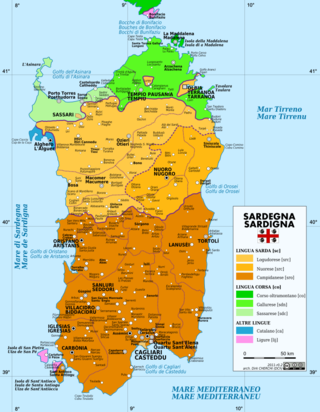Logudorese Sardinian
This article may require copy editing for grammar, style, cohesion, tone, or spelling. (March 2016) |
This article needs additional citations for verification. (December 2009) |
You can help expand this article with text translated from the corresponding article in Italian. (January 2012) Click [show] for important translation instructions.
|
| Logudorese Sardinian | |
|---|---|
| Sardu Logudoresu, Logudoresu | |
| Native to | Italy |
| Region | Sardinia |
Native speakers | (500,000 cited 1993)[1] |
| Language codes | |
| ISO 639-3 | src |
| Glottolog | logu1236 |
| ELP | Logudorese Sardinian |
| Linguasphere | 51-AAA-sa |
 Languages and dialects of Sardinia | |
Logudorese Sardinian (Template:Lang-sc, Template:Lang-it) is a standardised variety of Sardinian, often considered the most conservative of all Romance languages. Its ISO 639-3 code is src.
Latin G and K before /i, e/ were not palatalized in it, in stark contrast with all other Romance languages. Compare Logudorese Template:Wiktsrd with Italian Template:Wiktita /ˈtʃɛnto/, Spanish Template:Wiktspa /ˈθjento/, /ˈsjento/ and French Template:Wiktfra /sɑ̃/.
Logudorese is intelligible to those from the southern part of Sardinia, where Campidanese Sardinian is spoken,[citation needed] and partly unintelligible to those from the extreme north of the island, where Corsican–Sardinian dialects are spoken.[citation needed] Italian speakers can hardly understand Logudorese: Sardinian is not a dialect of Italian as is often asserted.
Location and distribution
The name refers to the area of Logudoro (term originated as corrupt blending of the kingdom's name of Logu de Torres) in which it is spoken, a northern subregion of the island of Sardinia with close ties to Ozieri (Othieri) and Nuoro (Nùgoro) for culture and language, as well as history, with important particularities in the western area, where the most important town is Ittiri. Roughly it is an area of 150 × 100 km, with some 500,000–700,000 inhabitants.
Origins and features
The language's origins have been investigated by several authors; Eduardo Blasco Ferrer's investigation is one of the most thorough. The language derives from Latin, and has been influenced by Catalan and Spanish due to the dominion of the Crown of Aragon and later the Spanish Empire over the island. Logudorese is the northern macro-dialect of the Sardinian language, the southern macro-dialect being Campidanese, spoken in the southern half of the island. The two variants share a clear common origin and history, but have experienced somewhat different developments.
Though the language is typically Romance, some words in it are not of Latin origin, and often are of uncertain etymology. One such is "nura", found in "nuraghe", the main form of pre-Roman building, hence the term for the pre-Roman era as the Nuragic Period. Various place names similarly have roots which defy analysis.
Due to the particular history of the area, Logudorese has changed only very slowly from Vulgar Latin in comparison to other Romance lects, even though in terms of vocabulary it is not as close to its Latin ancestor as Italian. Campidanese, in contrast, has sometimes more archaic features than Logudorese, particularly in its verb forms, such as the retention of the 3rd-person plural in -nt(), which is reduced to -n() in Logudorese.
Subvariants of the dialect
Logudorese has a number of dialects, some confined to individual villages or valleys. Though such differences can be noticeable, all the dialects are mutually intelligible, and share some mutual intelligibility with the neighbouring Campidanese dialects.
Writers
A large body of Sardinian poetry, songs and literature is composed in Logudorese.
See also
External links
- Ditzionàriu online - Dizionario della lingua sarda
- A iscola de sardu - Sassari.tv
- Logudorese basic lexicon at the Global Lexicostatistical Database
- Sardinian basic phrases
- Historic Grammar of Sardinian language
References
- ^ Logudorese Sardinian at Ethnologue (18th ed., 2015) (subscription required)
